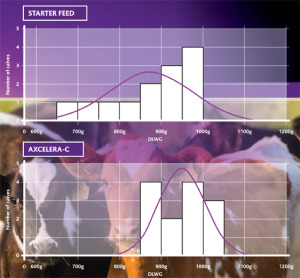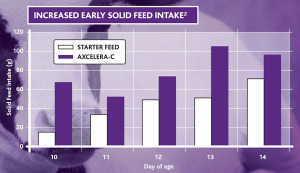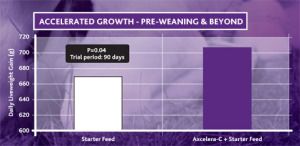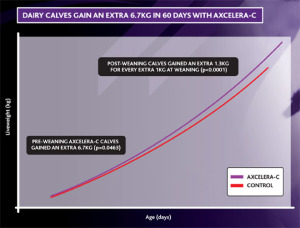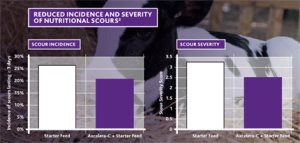Katherine Moore. AB Neo Technical Sales and Support Manager
It is becoming widely recognised that neonates hold the key to switching on lifetime performance in farm animals.
By positively manipulating the way a calf is fed and managed in early life, it is possible to switch on bodily functions that have the potential to accelerate life-long changes to improve efficiency, milk yields and ultimately lifetime profitability. Without the correct management at this early stage, opportunities to program the animal for higher lifetime productivity can never be recovered.
In the dairy herd, farmers strive to produce a strong and healthy heifer that will grow efficiently, calve down successfully at an optimal age, and produce a high volume of quality milk throughout its lifetime without compromising fertility or longevity. Research in the last 15 years both in Europe and America has shown a correlation between maximising pre-weaning growth rates and reducing age at first calving, improving future milk yields, health and longevity.
Investing for the future
A dairy heifer takes at least two years before she becomes a productive animal, and typically only recovers her rearing costs midway through her second lactation before starting to yield a profit! Due to this apparent lag in financial return, some producers give heifers a lower commercial priority, which is effectively harming their future herd’s potential.
More progressive producers who recognise how vital the neonate window of opportunity is for achieving lifetime performance are now moving away from conventional rearing methods which effectively restrict milk feeding, and can be detrimental to calf health and growth. They are now feeding higher quality, more concentrated or higher volumes of milk replacer to the calf and when managed effectively this can help to promote calf health and growth rates, with associated lifetime benefits. However, this can also come at a cost, and with widely experienced issues such as increased labour, risk of scouring and reduction in solid feed intake. This type of feeding regime needs to be very carefully managed to be successful and ultimately profitable. The move to increased intakes of calf milk replacer can also limit starter intake that is so crucial to the development of the rumen and hence future calf performance, and is associated with growth checks at weaning.
Being aware of the limitation of some of the current conventional methods of calf rearing and how fundamental to lifetime performance it is for the calf to get the best start, there was an opportunity to develop something completely different in order to enhance lifetime development in calves further but without some of the well-known drawbacks of relying solely on high CMR intakes. By using a proprietary method of processing a specific milk-based formulation in a unique way it has been possible to create an extremely palatable, highly digestible lactose-rich pellet that is easy to feed from just a few hours of age through to weaning. As such, farmers do not encounter the problems experienced with some conventional methods of trying to increase a calf’s lactose intake.
A new method for dairy farmers
Axcelera-C is easy to use on-farm, with no mixing or heating required – it can simply be scooped directly into the feed trough or bucket. The palatability of the pellets entices the calf to consume more solid feed, earlier in life compared to other alternative feeding strategies that aim to increase nutrient delivery to calves.
Whilst increasing liquid milk provision for calves can promote rapid growth rates, this can be difficult to manage and limits solid feed intake. As solid feed intake is key to promoting rumen epithelium development and microflora establishment in preparation for weaning, the earlier this can be achieved, the more successful the weaning process becomes, allowing for more efficient growth and a healthier animal in the long term.
Axcelera-C is pelleted and is offered alongside standard milk as the first solid feed from three days of age, replacing starter concentrates for the first three weeks of life, and then placed on top of starter pellets or coarse mix at 150g per head per day thereafter until weaning. With group housed calves of differing ages, Axcelera-C is blended with the starter feed and fed at a flat rate of 15% until weaning. Some producers choose to blend Axcelera-C with the starter feed for a week beyond weaning to continue accelerated feed intakes in this potentially stressful period.
By blending with a starter feed, the calf is trained to consume solid feed from an early age which helps to further advance rumen development in preparation for earlier weaning.
On-Farm Performance
Trials show that calves offered Axcelera-C are instantly attracted by the strong, sweet smell and consume this solid high lactose system aggressively from just a few days of age.
Fig 1. Increased calf DLWG and uniformity
A significantly increased feed intake compared to a conventional starter feed, over and above allocated milk provision means that the calf consumes more lactose and energy earlier in life. Crucially the calf is ingesting more energy at the fundamental lifestage when it is converting at its most efficient and laying fundamental foundations for its lifetime performance.
Direct into the rumen
Because Axcelera-C is a solid composed predominantly of milk ingredients, these ultra high lactose pellets pass directly into the rumen, accelerating the development of this crucial organ. This is a completely different destination to the liquid milk, which triggers the closure of the oesophageal groove and is redirected away from the rumen into the abomasum. This means that farmers who may already be maximising intakes of calf milk replacer can safely increase lactose intakes further without increasing the risk of nutritional scours by offering their calves Axcelera-C.
Fig 2. Increased feed intake and daily live weight gain in calves
Research has shown that once a calf is consuming a significant quantity of solid feed each day, it takes about three weeks for the rumen to develop sufficiently to allow for a successful weaning, where sufficient energy can be absorbed from a non-liquid diet for the calf to prevent a stalling in growth. By encouraging earlier and increased solid feed intake pre-weaning, the accelerated approach provides the calf with the best chance of transitioning successfully.
Proven on-farm and in trials.
This has been confirmed in a number of studies measuring the performance of Axcelera-C. An on-farm trial in the UK where Axcelera-C was blended into the starter feed for dairy bull calves between 31 and 91 days of age (later than recommended for optimal neonatal development) gave an extra 6.7kg (P=0.0463) growth and also improved the homogeneity of the calves.
Fig.3 Accelerated calves grow faster
Fig.3 Reduced incidence and severity of nutritional scours in calves
Working in collaboration with Professor Alex Bach at IRTA in Barcelona, our trial data shows that neonatal calves offered Axcelera-C had an increased early feed intake and daily liveweight gain. This improvement was also accompanied by a 20% reduction in the incidence of scours as well as a 33% reduction in severity of any scours, which has significant economic implications for the producer not only in terms of medical treatment, but in labour costs and lost growth.
Axcelera-C is a proven method for farmers to achieve accelerated growth in neonates, helping to achieve the widely recognised lifetime benefits of optimising calf development. It's a working example of how innovation can really benefit the dairy farmer through both easier management and improved lifetime performance.
Previously published in International Dairy Topics: Vol 14: Number 6
